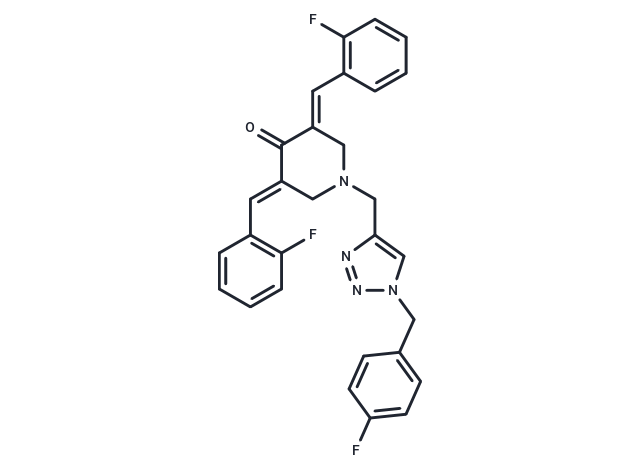Shopping Cart
- Remove All
 Your shopping cart is currently empty
Your shopping cart is currently empty

CT-1 is a DNA minor groove ligand and causes p53-dependent breast cancer cell apoptosis.

| Pack Size | Price | Availability | Quantity |
|---|---|---|---|
| 1 mg | $117 | In Stock | |
| 5 mg | $262 | In Stock | |
| 10 mg | $387 | In Stock | |
| 25 mg | $592 | In Stock | |
| 50 mg | $828 | In Stock | |
| 100 mg | $1,110 | In Stock | |
| 500 mg | Inquiry | In Stock |
| Description | CT-1 is a DNA minor groove ligand and causes p53-dependent breast cancer cell apoptosis. |
| Alias | CT 1 |
| Molecular Weight | 500.51 |
| Formula | C29H23F3N4O |
| Cas No. | 1983924-33-9 |
| Smiles | C(=C\1/C(=O)\C(=C\C2=C(F)C=CC=C2)\CN(CC3=CN(CC4=CC=C(F)C=C4)N=N3)C1)\C5=C(F)C=CC=C5 |
| Relative Density. | 1.27 g/cm3 (Predicted) |
| Storage | Powder: -20°C for 3 years | In solvent: -80°C for 1 year | Shipping with blue ice. | |||||||||||||||
| Solubility Information | DMSO: 5 mg/mL (9.99 mM), Sonication is recommended. | |||||||||||||||
Solution Preparation Table | ||||||||||||||||
DMSO
| ||||||||||||||||

Copyright © 2015-2025 TargetMol Chemicals Inc. All Rights Reserved.